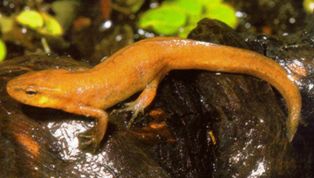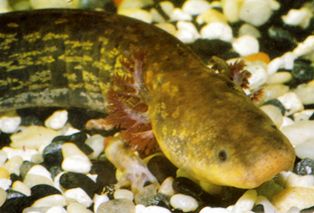Discover Florida Nature
It's time to explore the natural Florida


|
|
|
|
|
A newt is a type of salamander that lives in water during both its
larval and final adult stages. One of the most interesting things about
newts is that their larvae transform into creatures called efts which
leave the water and live on land for a year or two. The efts then
transform into the adult newts which return to the water and which for
the rest of their lives are largely aquatic! In Florida, only the
Striped Newt has efts. One of the characteristics of newts that
distinguish it from other salamanders is their very toxic skin
secretions, something the witches in Shakespeare's Macbeth were well
aware of when they added eye of newt in their evil brew. Peninsula
Newt- The peninsula newt is a darker form of the eastern newt
and lacks red spots entirely. Individuals range from greenish-brown to
almost black and are heavily speckled with black spots. The venter may
also be a deeper orange color than the typical yellow of the other
forms. The eft stage is usually skipped and neoteny is frequent. This
variety is only found in peninsular Florida. This little newt can be
found in most bodies of fresh water, except swiftly flowing rivers. The
Peninsula Newt stays below the surface most of the time, but
occasionally emerges to walk about on floating vegetation. A good way to
find a Peninsula newt in central Florida is to dip a minnow net into an
area lake or pond. Peninsula
Newt- The peninsula newt is a darker form of the eastern newt
and lacks red spots entirely. Individuals range from greenish-brown to
almost black and are heavily speckled with black spots. The venter may
also be a deeper orange color than the typical yellow of the other
forms. The eft stage is usually skipped and neoteny is frequent. This
variety is only found in peninsular Florida. This little newt can be
found in most bodies of fresh water, except swiftly flowing rivers. The
Peninsula Newt stays below the surface most of the time, but
occasionally emerges to walk about on floating vegetation. A good way to
find a Peninsula newt in central Florida is to dip a minnow net into an
area lake or pond. Broken
Striped Newt- Newts are the amphibians of the salamander
family. They have long slender bodies like those of lizards with a tail
that is flattened laterally. The Broken-Striped Newt is about 2 5/8” to
5 1/2“ long. The black-bordered red stripe is broken in at least 1 or 2
places on the head and trunk; however, it rarely extends onto the tail.
There may be a row of small red spots on the lower sides of the body and
a light line down the center of the back. During their “eft” stage,
Broken-Striped Newts are reddish brown in color. The red stripes are
not so strongly bordered by black as in the adult stage. In the wild,
Newts eat worms, crickets, insects, amphibian eggs and larvae. Newts
secrete a toxic substance through their skin, so fish and other
predators avoid them. This substance will burn if it gets into your
eyes. Broken
Striped Newt- Newts are the amphibians of the salamander
family. They have long slender bodies like those of lizards with a tail
that is flattened laterally. The Broken-Striped Newt is about 2 5/8” to
5 1/2“ long. The black-bordered red stripe is broken in at least 1 or 2
places on the head and trunk; however, it rarely extends onto the tail.
There may be a row of small red spots on the lower sides of the body and
a light line down the center of the back. During their “eft” stage,
Broken-Striped Newts are reddish brown in color. The red stripes are
not so strongly bordered by black as in the adult stage. In the wild,
Newts eat worms, crickets, insects, amphibian eggs and larvae. Newts
secrete a toxic substance through their skin, so fish and other
predators avoid them. This substance will burn if it gets into your
eyes.Sirens are basically salamanders that got stuck in the larval stage permanently. Sirens never left the water, as do most amphibians. They breathe with feathery external gills that are located just behind the head, but they also have lungs, which they use extensively. Furthermore sirens also breathe through their skin to some extent. Sirens have a pair of very small front legs and no back legs. Amazingly sirens can seal themselves into dry mud when their shallow-water habitats evaporate. The siren's body secretes a coating which hardens and protects them from loss of moisture. Sirens emerge again with the coming of rain. Many Southern people in the state of Florida call them eels.  Greater
Siren- The greater siren is found in calm, hyacinth-covered
lakes and slow-moving rivers and canals throughout the state. It is gray
green or brown with lighter flecks along the sides. The Greater Sirens
external gills are usually dark red and the tip of its tail is rounded.
It has four toes on each leg. A greater siren reaches a maximum length
of 38.5 inches. This siren is nocturnal and searches the lake bottom and
thick vegetation for food. Greater
Siren- The greater siren is found in calm, hyacinth-covered
lakes and slow-moving rivers and canals throughout the state. It is gray
green or brown with lighter flecks along the sides. The Greater Sirens
external gills are usually dark red and the tip of its tail is rounded.
It has four toes on each leg. A greater siren reaches a maximum length
of 38.5 inches. This siren is nocturnal and searches the lake bottom and
thick vegetation for food. Eastern
Lesser Siren- The eastern Lesser Siren is found in shallow
quiet waters in north Florida and in scattered areas in central Florida.
It is slender, black to slate gray with dark spots, and has a pointed
tail. The eastern lesser siren has four toes on each leg and reaches a
length of 26 inches. this siren's diet consists primarily of aquatic
invertebrates. The female lays eggs in the mud in December and guards
them until they hatch in March. The tiny (0.4") larvae look like the
adults but have a red band across their heads. Eastern
Lesser Siren- The eastern Lesser Siren is found in shallow
quiet waters in north Florida and in scattered areas in central Florida.
It is slender, black to slate gray with dark spots, and has a pointed
tail. The eastern lesser siren has four toes on each leg and reaches a
length of 26 inches. this siren's diet consists primarily of aquatic
invertebrates. The female lays eggs in the mud in December and guards
them until they hatch in March. The tiny (0.4") larvae look like the
adults but have a red band across their heads. Everglades
Dwarf Siren- The Everglades dwarf siren is one of five dwarf
sirens found in the state of Florida. This dwarf siren can be found near
water hyacinths, and lives among the roots of these plants where it
searches for aquatic insects. Reaching only 6 inches in length, the
Everglades dwarf siren has bold buff to yellow striping and its head is
pointed. Everglades
Dwarf Siren- The Everglades dwarf siren is one of five dwarf
sirens found in the state of Florida. This dwarf siren can be found near
water hyacinths, and lives among the roots of these plants where it
searches for aquatic insects. Reaching only 6 inches in length, the
Everglades dwarf siren has bold buff to yellow striping and its head is
pointed. |
|
|
Advertise | Privacy Statement | Dog Encyclopedia | Video |Contact | Alaska Nature |
|